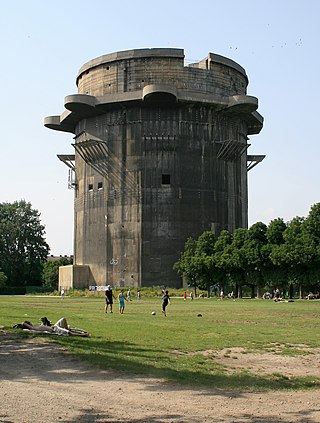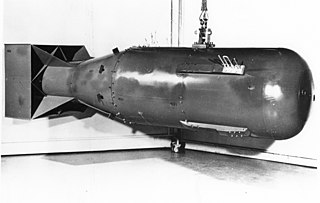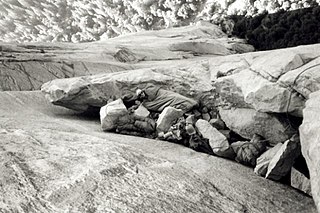
A bunker is a defensive military fortification designed to protect people and valued materials from falling bombs, artillery, or other attacks. Bunkers are almost always underground, in contrast to blockhouses which are mostly above ground. They were used extensively in World War I, World War II, and the Cold War for weapons facilities, command and control centers, and storage facilities. Bunkers can also be used as protection from tornadoes.

Hypothermia is defined as a body core temperature below 35.0 °C (95.0 °F) in humans. Symptoms depend on the temperature. In mild hypothermia, there is shivering and mental confusion. In moderate hypothermia, shivering stops and confusion increases. In severe hypothermia, there may be hallucinations and paradoxical undressing, in which a person removes their clothing, as well as an increased risk of the heart stopping.

Camping is a form of outdoor recreation or outdoor education involving overnight stays with a basic temporary shelter such as a tent. Camping can also include a recreational vehicle, sheltered cabins, a permanent tent, a shelter such as a bivy or tarp, or no shelter at all. Typically, participants leave developed areas to spend time outdoors, in pursuit of activities providing them enjoyment or in a form of educational experience. Spending the night away from home distinguishes camping from day-tripping, picnicking, and other outdoor activities.

A tent is a shelter consisting of sheets of fabric or other material draped over, attached to a frame of poles or a supporting rope. While smaller tents may be free-standing or attached to the ground, large tents are usually anchored using guy ropes tied to stakes or tent pegs. First used as portable homes by nomads, tents are now more often used for recreational camping and as temporary shelters.

A tarpaulin or tarp is a large sheet of strong, flexible, water-resistant or waterproof material, often cloth such as canvas or polyester coated with polyurethane, or made of plastics such as polyethylene. Tarpaulins often have reinforced grommets at the corners and along the sides to form attachment points for rope, allowing them to be tied down or suspended.

An emergency shelter is a place for people to live temporarily when they cannot live in their previous residence, similar to homeless shelters. The main difference is that an emergency shelter typically specializes in people fleeing a specific type of situation, such as natural or man-made disasters, domestic violence, or victims of sexual abuse. A more minor difference is that people staying in emergency shelters are more likely to stay all day, except for work, school, or errands, while homeless shelters usually expect people to stay elsewhere during the day, returning only to sleep or eat. Emergency shelters sometimes facilitate support groups, and/or provide meals.

Backpacking is the outdoor recreation of carrying gear on one's back while hiking for more than a day. It is often an extended journey and may involve camping outdoors. In North America, tenting is common, where simple shelters and mountain huts, widely found in Europe, are rare. In New Zealand, hiking is called tramping, and tents are used alongside a nationwide network of huts. Hill walking is equivalent in Britain, though backpackers make use of a variety of accommodation, in addition to camping. Backpackers use simple huts in South Africa. Trekking and bushwalking are other words used to describe such multi-day trips.

A poncho is a kind of plainly formed, loose outer garment originating in the Americas, traditionally and still usually made of fabric, and designed to keep the body warm. Ponchos have been used by the Native American peoples of the Andes, Patagonia, and the Valley of Mexico since pre-Hispanic times, in places now under the territory of Argentina, Bolivia, Brazil, Chile, Colombia, Ecuador, Mexico, Peru, Uruguay, and Venezuela, and have also become familiar in parts of the U.S. A rain poncho is made from a watertight material designed to keep the body dry from the rain.

Survival skills are techniques used to sustain life in any type of natural environment or built environment. These techniques are meant to provide basic necessities for human life, including water, food, and shelter. Survival skills also support proper knowledge and interactions with animals and plants to promote the sustaining of life over time.

A blast shelter is a place where people can go to protect themselves from blasts and explosions, like those from bombs, or in hazardous worksites, such as on oil and gas refineries or petrochemical facilities. It differs from a fallout shelter, in that its main purpose is to protect from shock waves and overpressure instead of from radioactive precipitation, as a fallout shelter does. It is also possible for a shelter to protect from both blasts and fallout.
A basha is a waterproof canvas or plastic sheet with eyelets or loops on the perimeter, which is used in camping, outdoor, or military situations to act as a shelter, in the form of an impromptu tent and/or groundsheet, usually supported with rope or even bungee cords attached to trees.

Bushcraft is the use and practice of skills, thereby acquiring and developing knowledge and understanding, in order to survive and thrive in a natural environment.

A bivouac shelter or bivvy is any of a variety of improvised camp site or shelter that is usually of a temporary nature, used especially by soldiers or people engaged in backpacking, bikepacking, scouting or mountain climbing. It may often refer to sleeping in the open with a bivouac sack, but it may also refer to a shelter constructed of natural materials like a structure of branches to form a frame, which is then covered with leaves, ferns and similar material for waterproofing and duff for insulation. Modern bivouacs often involve the use of one- or two-person tents but may also be without tents or full cover. In modern mountaineering the nature of the bivouac shelter will depend on the level of preparedness, in particular whether existing camping and outdoor gear may be incorporated into the shelter.

A hut is a small dwelling, which may be constructed of various local materials. Huts are a type of vernacular architecture because they are built of readily available materials such as wood, snow, ice, stone, grass, palm leaves, branches, clay, hides, fabric, or mud using techniques passed down through the generations.

A quinzhee or quinzee is a Canadian snow shelter made from a large pile of loose snow that is shaped, then hollowed. This is in contrast to an igloo, which is built up from blocks of hard snow, and a snow cave, constructed by digging into the snow. The word is of Athabaskan origin and entered the English language by 1984. A quinzhee can be made for winter camping and survival purposes, or for fun.

A fly refers to the outer layer of a tent or to a piece of material which is strung up using rope as a minimalist, stand-alone shelter. In basic terms, a fly is a tent without walls. Purpose-made stand-alone flies are also sometimes referred to as bivouacs, bivvies, tarpaulins, or hootchies. Flies are generally used for keeping moisture or sun off people while they eat, rest or sleep. They can also be used as groundsheets, but this is not recommended since it creates wear and tear which can lead to holes.

Refugee shelters are structures ranging from the most temporary tent accommodation through transitional shelter to building temporary pics and settlements and include the most basic kind of ad hoc structure. They are created in the aftermath of a conflict or natural disaster as a temporary residence for victims who have lost or abandoned their homes. Refugees and IDPs are people fleeing their homes or countries of origin due to natural disasters, war and political or religious persecution in search of refuge and resettlement. Living in these shelters refugees may force marriage crowded, noisy, dirty, disease filled grounds where thousands of families are cramped together and surviving day by day.

Ultralight backpacking is a style of lightweight backpacking that emphasizes carrying the lightest and least amount of gear. While no technical standards exist, some hikers consider "ultralight" to mean an initial base weight of less than 4.5 kg (9.9 lb). Base weight is the weight of a fully loaded backpack at the start of a trip, excluding worn weight and consumables such as food, water, and fuel. Base weight can be lowered by reducing the weight of individual items of gear, or by choosing not to carry that gear. Ultralight backpacking is most popular among thru-hikers.
Hiking equipment is the equipment taken on outdoor walking trips. The duration, distance, planned activities, and environment impacts equipment selection. For example, a short day hike across flat farmland versus trekking in the Himalayas would call for different types of equipment.

A shell scrape is a type of military earthwork dug at a shallow but sufficient depth in the ground where a soldier can take shelter from weapons fire. While similar to a defensive fighting position in that the purpose is to shield a single soldier from artillery, mortar and direct small arms fire, it is not intended to be used for fighting from.

















